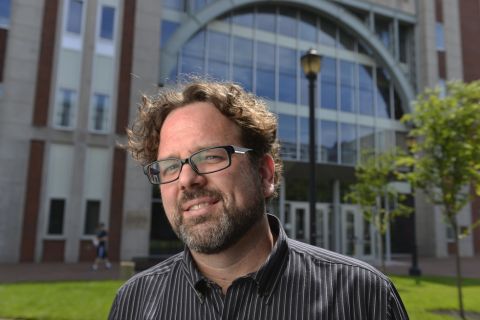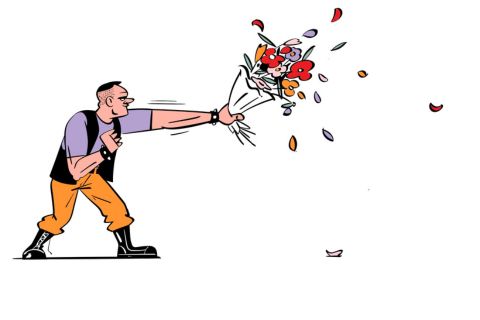Can people change?
Professor Shadd Maruna thinks so, but his work on ‘desistance’ from crime suggests we need a new approach.
.jpg)
Gethin Jones had been in trouble since he was 14. Abandoned as a child by a mother who herself had been abandoned, Gethin grew up surviving on his wits before spiralling into a toxic life of crime and drugs, punctuated by regular spells in prison. His life was that of a classic repeat offender. But it was there, in prison, that he found himself inspired by the positive experiences shared by a drugs counsellor – himself a recovering addict – and began to ‘go straight’. What was behind the transformation? Hope and a good story.
“To people in prison, there is nothing fluffy about hope,” explains Jones’ friend Professor Shadd Maruna of the School of Social Sciences, Education and Social Work, in the foreword of Good Stories: Telling Against Trouble. “Hope is not just a big thing in prison, it may be the only thing. What is the difference between the person who gives up on life and overdoses on the cell floor, and the person who survives prison and proves to all the doubters that they can succeed without drugs, without stealing? Anyone inside will tell you that the first person lost hope and the second one found it. We may dismiss that, but if you keep talking to those inside, you might meet someone who will tell you exactly where to find that hope: the power of good stories. That is real enough for me.”

Professor Shadd Maruna studies routes out of criminality and ways that the justice system impedes this process of desistance.
The world of crime and punishment is tough but the language we use for it doesn’t have to be, explains Professor Maruna. “If we want to talk about what makes people stop committing crimes and stay out of prison, we need a different language.” This is why he has dedicated his 25-year career to understanding ‘desistance’ from crime, which is essentially the study of how people change. And the language we need is that of hope: believing that someone can change. This, Professor Maruna says, is core to desistance.
Yet, despite powerful redemption narratives running through our culture, such as our love for films like The Shawshank Redemption, we are actually suspicious about whether people really can change. As Professor Maruna explains: “Since the 1990s, we have believed in the myth of the ‘persistent offender’, the person who can’t help themselves and must be put away – justifying legal concepts such as life without parole, even for under-18s, until recently. These are the people whose brains are just wired that way. The psychopaths, at their extreme.”
However, this narrative goes against all the evidence we have about offending, adds Professor Maruna, who is also President of the American Society of Criminology. Take the age-crime curve, which shows that most crime happens in youth (although recent evidence shows even young people are offending less than before) and tails off with age, after a period of 10 to 20 years.
“Even in the face of evidence like this, as a society we still tend to ask: ‘Have they really changed?’ And this is where stories come in. With stories we can reach people who work in the justice system, academics and members of the public, and instead of just telling them about the evidence, we can show them that people can, and do, change.”
Stories of change, like that of Gethin Jones, who now works as a motivational speaker, are impactful for the listener, he says, but they’re also essential for the desister who is trying to re-enter society. “The ex-prisoner trying to get housing or a job or into university needs a good story that explains convincingly why they did what they did and why they won’t do it again,” explains Professor Maruna.
In his book, Making Good, Professor Maruna explores hundreds of cases of people who desisted from or persisted with crime, and found that one of the key differences between the two was, perhaps surprisingly, the stories they told about themselves. “The ones who desisted had a good personal narrative. Often, they said that they had met someone – a teacher, a girlfriend or a coach, for example – who saw something in them; a hidden gift or talent, something they could be good at. This helped them turn their life around. Or they wanted to give something back.
Having harmed people, they wanted to make amends, perhaps to the person or their relatives, but also more widely, to help break the cycle of harm for others by working with young people, for example. And this had motivated them to change.”

Professor Maruna also points out that just as crime is social, so is desistance: “We talk about people being led into crime, and crime being committed in groups. So, it shouldn’t be surprising that people are also led into desistance – by a brother who joins Narcotics Anonymous, for instance, or a cell mate who starts studying. This is why the notion of mentoring is important for desistance. Reformed people going into prisons with their stories, or ‘credible messengers’, make excellent mentors.”
Because while wanting to change, and believing you can, is necessary for desistance, it is not sufficient. Social factors are at play in the kind of life that follows: “American researchers Laub and Sampson tracked down sample members of a famous 1940s study of juvenile delinquency and found none were still involved in crime,” explains Professor Maruna.
“But they didn’t necessarily find them living comfortably. People with strong social bonds have more to fall back on when they want to go straight. If you just talk about welfare, you take away a person’s agency – their dignity, their strength. But focusing only on agency ignores society’s constraints.”
The next step for the desistance movement, Professor Maruna says, is to change the societal obstacles faced by ex prisoners, and this movement is best led by those who have been through the system: “The work of rehabilitation is made 100 per cent easier if the people coaching and giving advice have lived experience.

“We start with stories, to pull people in, but we also need institutional change. Take the probation service in the United States: it has lost touch with its social work roots, and is dominated by surveillance – the stick. It could be the carrot – therapy. But in between could be a strength-based system that would recognise both risk and need, but focus on what the person has to offer and how that can be encouraged.
Through community service, for example. If done right, this can reveal strengths, as well as help build the networks the ex-prisoner needs to move on.” Employers also have a role, Professor Maruna says, citing British retailer Timpson Group, where the head of the company champions the ex-prisoners in his workforce.
Then there are laws that allow people to move on, or not. “Criminologists have identified countless laws and policies that prevent ex-prisoners pursuing non-criminal career options, from driving a taxi to cutting hair. But where are the laws to support rehabilitation?
For a custodial sentence of three or four years, an ex-prisoner must declare their convictions for at least seven years, by which point, if they’ve made it, expunging their record may not make much difference. Could we speed that time up, by rewarding volunteer work, for example? We could, but we don’t know what that looks like.
We have a million ways of recognising and describing criminality; we need as many ways of recognising, classifying and rewarding change.” Failure to do so, Professor Maruna warns, would be a failure of hope.